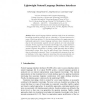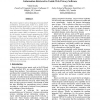IEEEICCI
2003
IEEE
14 years 5 months ago
2003
IEEE
In this paper, we focus on lexical semantics, a key issue in Natural Language Processing (NLP) that tends to converge with conceptual Knowledge Representation (KR) and ontologies....
SPATIALCOGNITION
2004
Springer
14 years 5 months ago
2004
Springer
Establishing a clean relationship between a robot’s spatial model and natural language components is a non-trivial task, but is key to designing verbally controlled, navigating s...
NLDB
2004
Springer
14 years 5 months ago
2004
Springer
Most natural language database interfaces suffer from the translation knowledge portability problem, and are vulnerable to ill-formed questions because of their deep analysis. To a...
MKM
2004
Springer
14 years 5 months ago
2004
Springer
This paper reports on refinements and extensions to the MathLang framework that add substantial support for natural language text. We show how the extended framework supports mult...
KES
2004
Springer
14 years 5 months ago
2004
Springer
ConceptNet is a very large semantic network of commonsense knowledge suitable for making various kinds of practical inferences over text. ConceptNet captures a wide range of common...
ITS
2004
Springer
14 years 5 months ago
2004
Springer
When implementing a tutoring system that attempts a deep understanding of students’ natural language explanations, there are three basic approaches to choose between; symbolic, i...
CIKM
2004
Springer
14 years 5 months ago
2004
Springer
A number of content management tasks, including term categorization, term clustering, and automated thesaurus generation, view natural language terms (e.g. words, noun phrases) as...
SIGIR
2004
ACM
14 years 5 months ago
2004
ACM
In this paper we study the problem of finding most topical named entities among all entities in a document, which we refer to as focused named entity recognition. We show that th...
IUI
2004
ACM
14 years 5 months ago
2004
ACM
A key to improving at any task is frequent feedback from people whose opinions we care about: our family, friends, mentors, and the experts. However, such input is not usually ava...
WEBI
2005
Springer
14 years 5 months ago
2005
Springer
We present a generic natural language processing (NLP) architecture, acronym QTIL, based on a system of cooperating multiple agents (Q/A, T, I, and L agents) which can be used in ...



